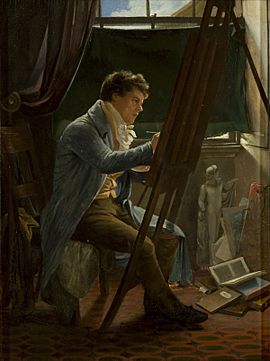Edward Bird facts for kids
Quick facts for kids
Edward Bird
|
|
|---|---|

Edward Bird by Edward Villiers Rippingille, 1817
|
|
| Born | 1772 |
| Died | 2 November 1819 |
| Nationality | English |
| Known for | Genre painting, History painting |
Edward Bird RA (1772 – 2 November 1819) was a talented English painter. He spent most of his life working in Bristol. There, a group of artists called the Bristol School formed around him.
For a few years, Edward Bird was very popular in London. He was known for his "genre paintings." These are pictures that show everyday life. Later, he started painting "history paintings," which are often big scenes of important events like battles.
Contents
Edward Bird's Early Life
Edward Bird was born in Wolverhampton in 1772. His father was a carpenter. Edward did not go to art school. Instead, he learned to paint by becoming an apprentice. He worked as a "japanning" artist. This meant he painted designs on things like tea trays.
In 1794, he moved to Bristol. There, he married Martha Dodrell. He started his own art career. He painted portraits (pictures of people). He also created drawings for books and painted for churches.
The Bristol School of Artists
In Bristol, Edward Bird became the center of an art group. This group later became known as the Bristol School. Many artists joined, including Edward Villiers Rippingille and Nathan Cooper Branwhite.
At first, many people in the group were amateur artists. This means they painted for fun, not as a job. Bird's close friends included John King, his doctor, and George Cumberland. Cumberland moved to Bristol in 1807. He became the godfather to Bird's son. Cumberland had a large art collection. He would often lend pieces to Bird to study.
The group often met in the evenings to sketch. They also went on trips to beautiful places around Bristol. They would sketch the landscapes they saw. Bird's painting Landscape with Cottage was likely made on one of these trips.
Bird did not paint many landscapes himself. He often went on the trips but did not always sketch. Edward Bird greatly influenced other Bristol artists. He taught them to paint everyday scenes in a natural way. He also showed them how to use fresh, bright colors. Edward Villiers Rippingille was especially influenced by Bird. In 1814, both artists showed paintings at the Royal Academy. Both paintings were titled The Cheat Detected. Francis Danby also moved to Bristol in 1813. He later became a leader of the Bristol School. Danby was also inspired by Bird's style of genre painting.
Bird's Success as an Artist
In 1809, Edward Bird showed his painting Good News at the Royal Academy. This was a genre painting of an old soldier. It was placed next to a painting by another famous artist, Sir David Wilkie. Bird's painting caught a lot of attention.
His popularity grew even more when the Prince Regent bought his painting The Country Choristers. The Prince Regent then asked Bird to paint Blind Man's Buff. Some of Bird's other famous works include Field of Chevy Chase and The Day after the Battle. Many people thought The Day after the Battle was his best work.
Bird became an associate of the Royal Academy in 1812. This was a big honor. In 1813, he was named the historical painter to Princess Charlotte. In 1815, he became a full member of the Royal Academy.
Edward Bird was sick for more than five years. He could not paint at all during the last year of his life. He passed away on November 2, 1819. He was buried in Bristol Cathedral. The next year, there was a special art show of his paintings. It was held to help his family. His son George later became a midshipman (a naval officer in training). Bird's friends helped pay for George's equipment. His daughter Martha became a watercolourist in Bristol. His younger daughter Harriet worked as a governess.
Images for kids


